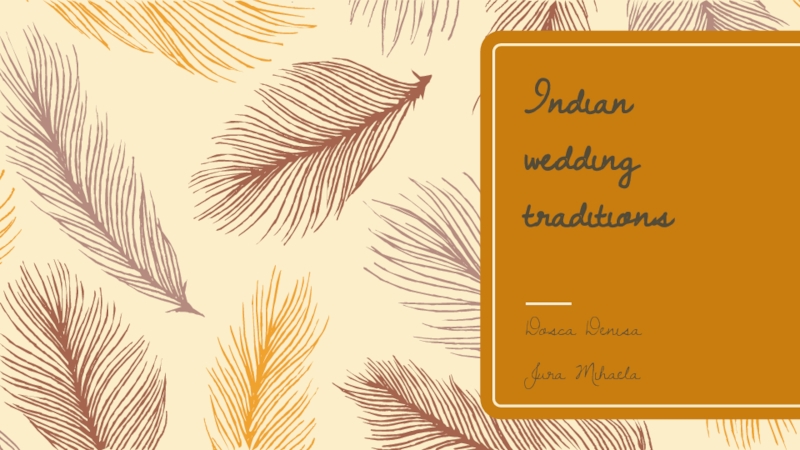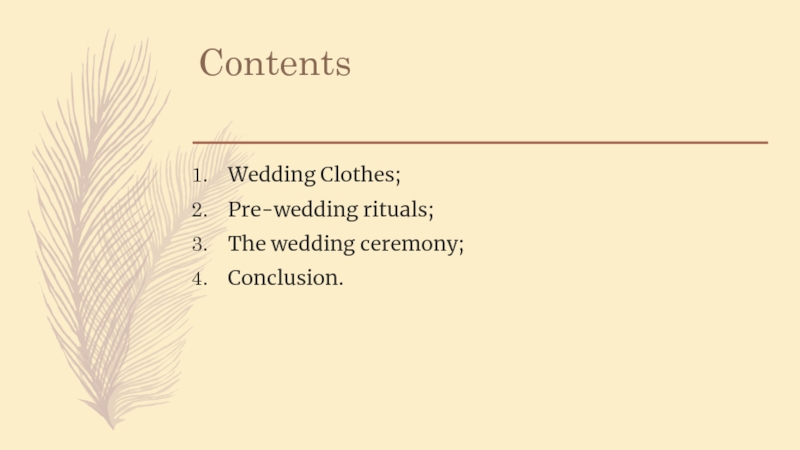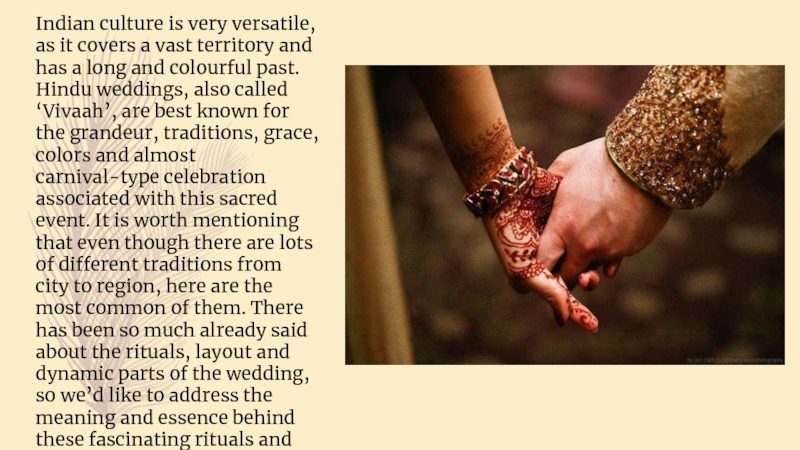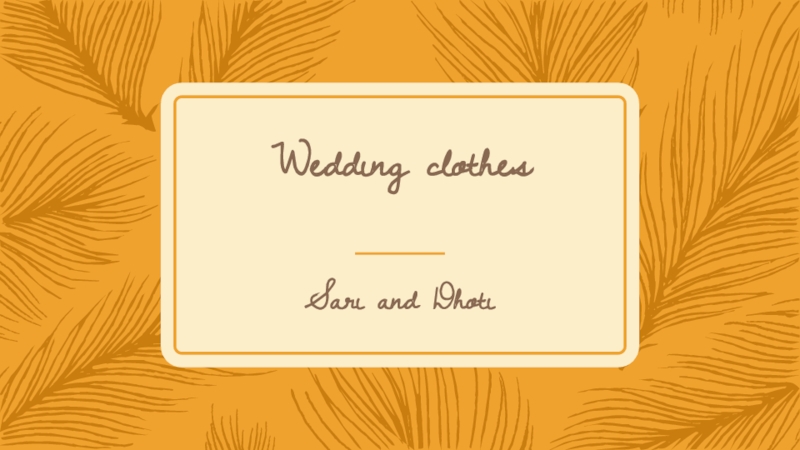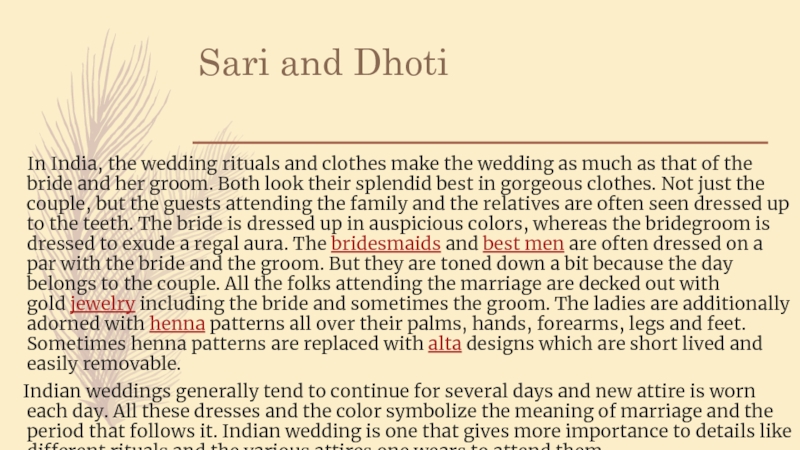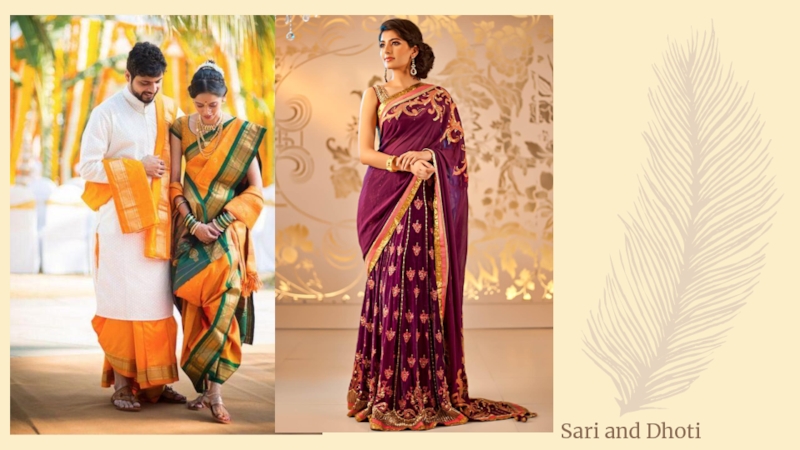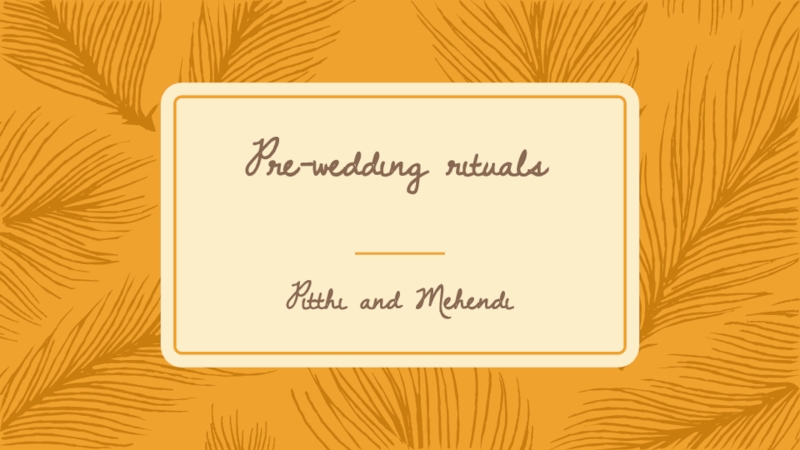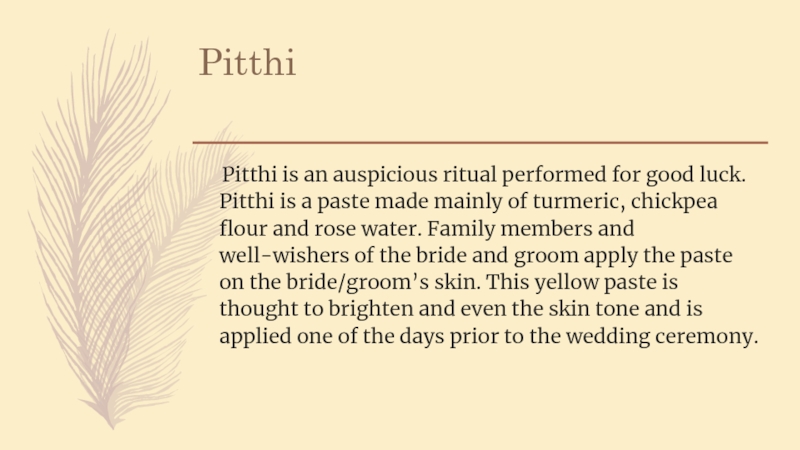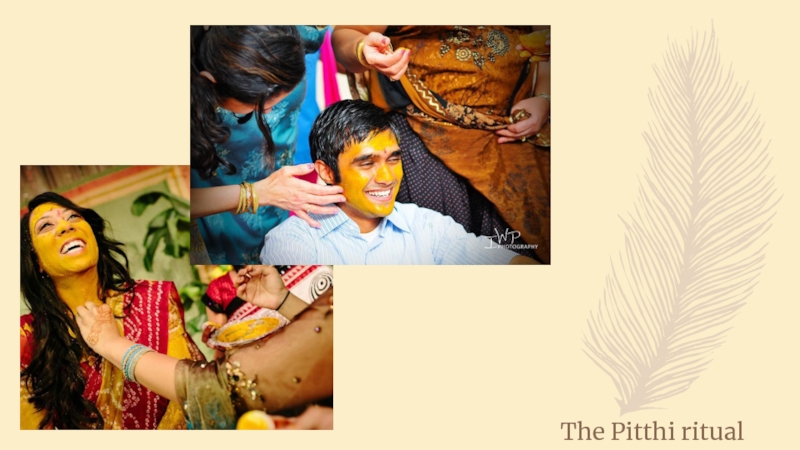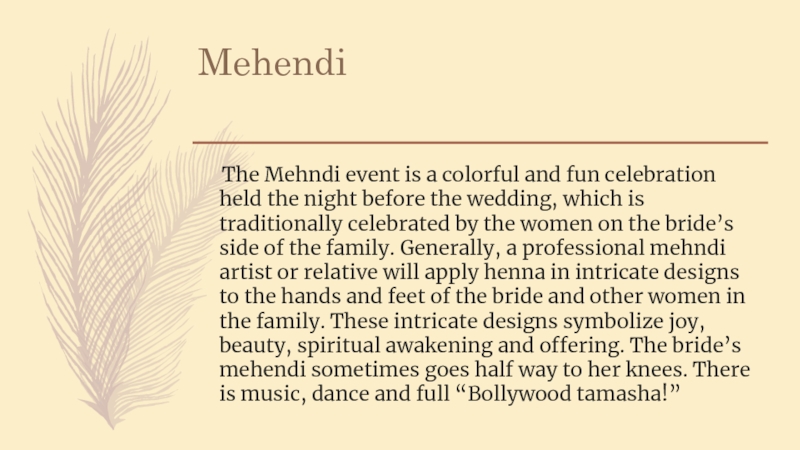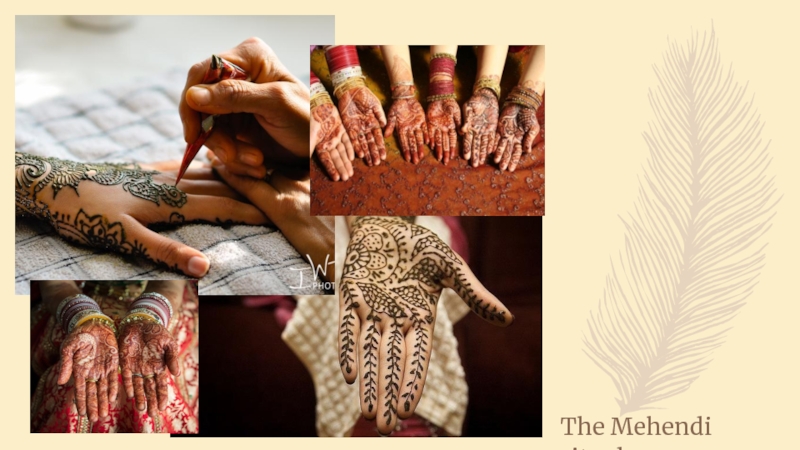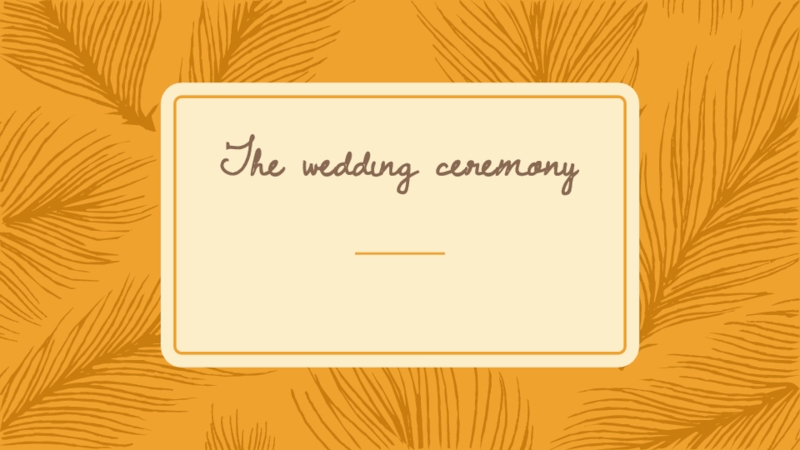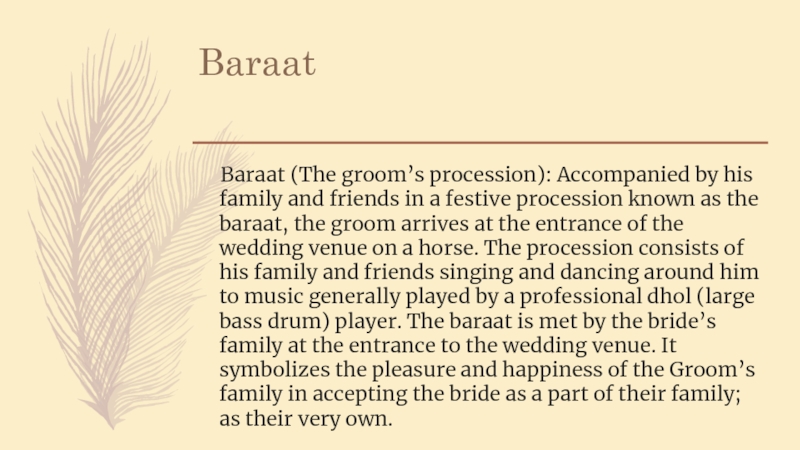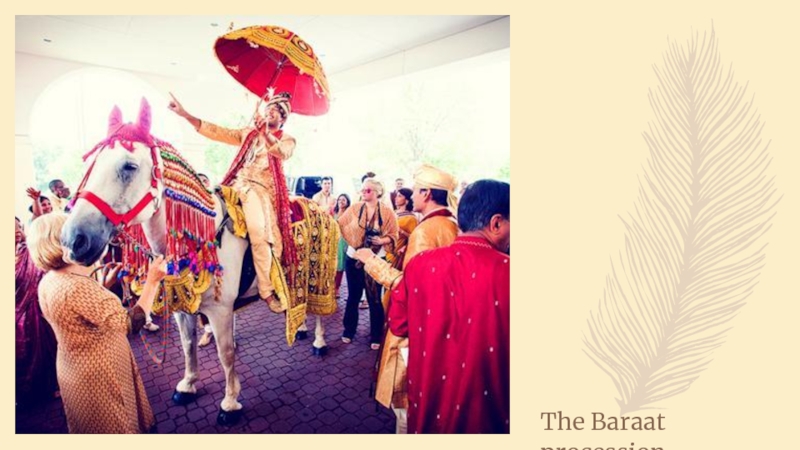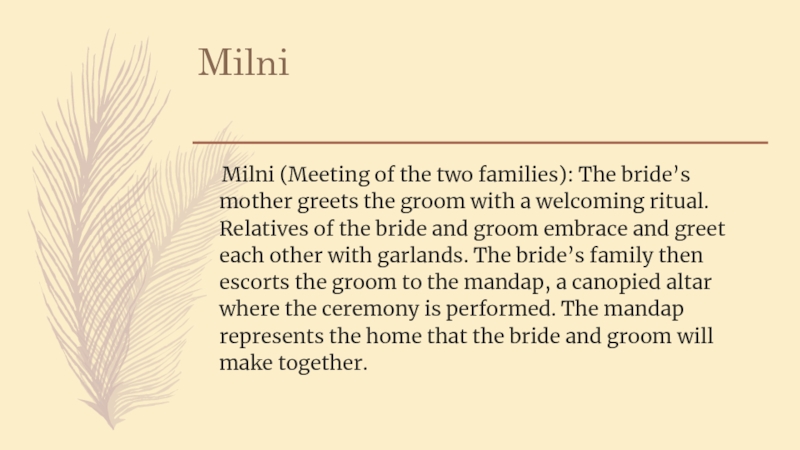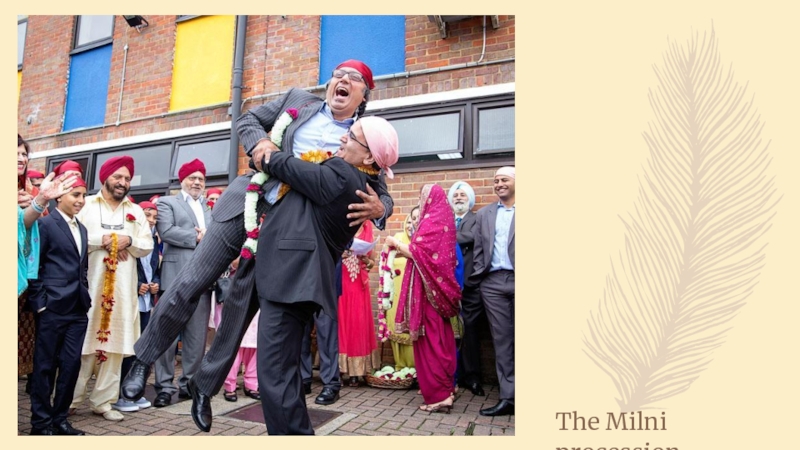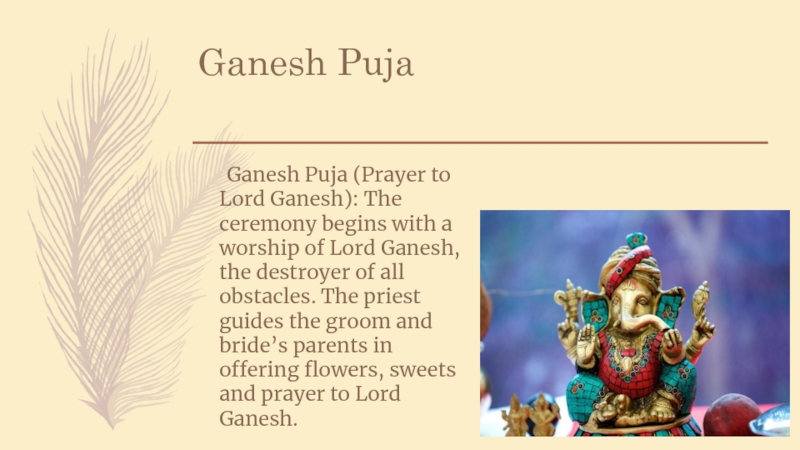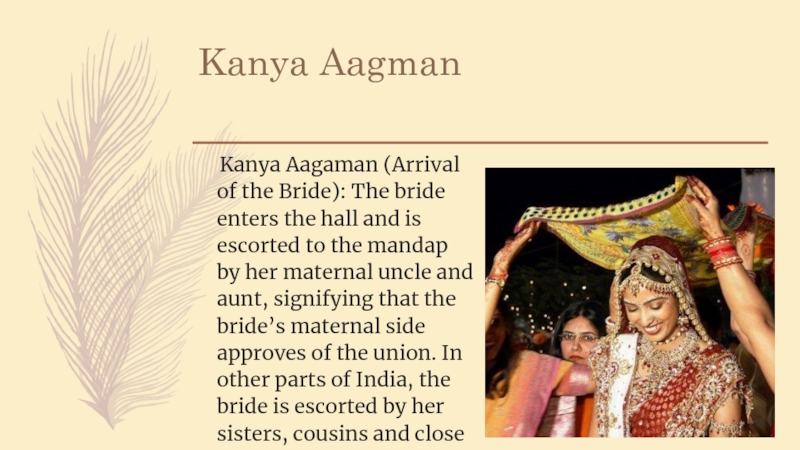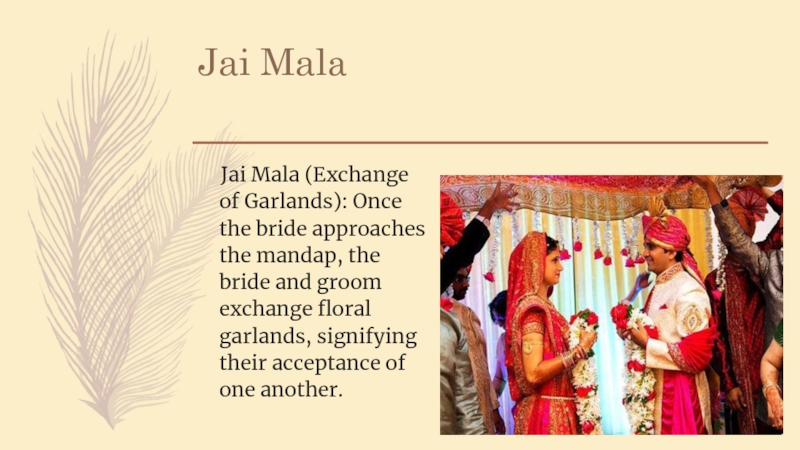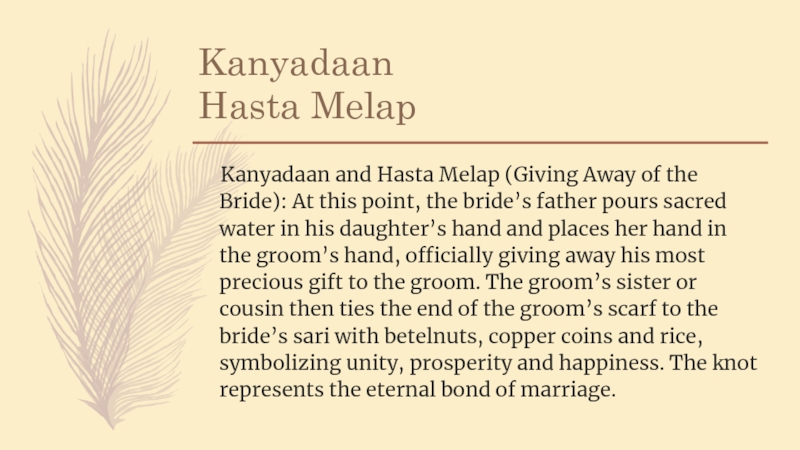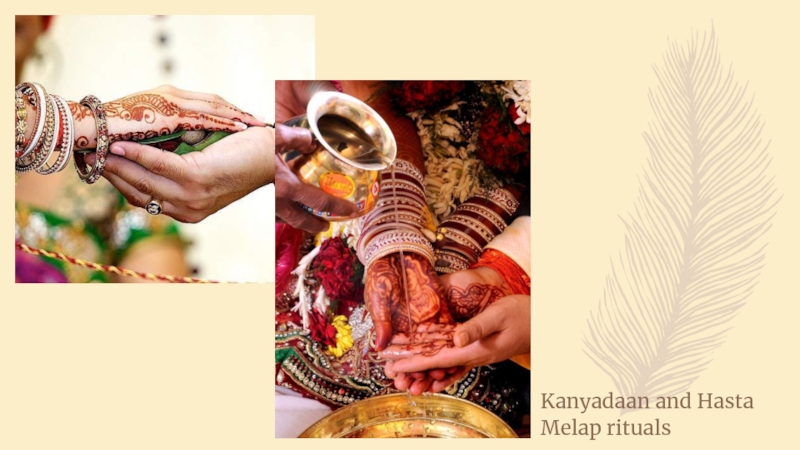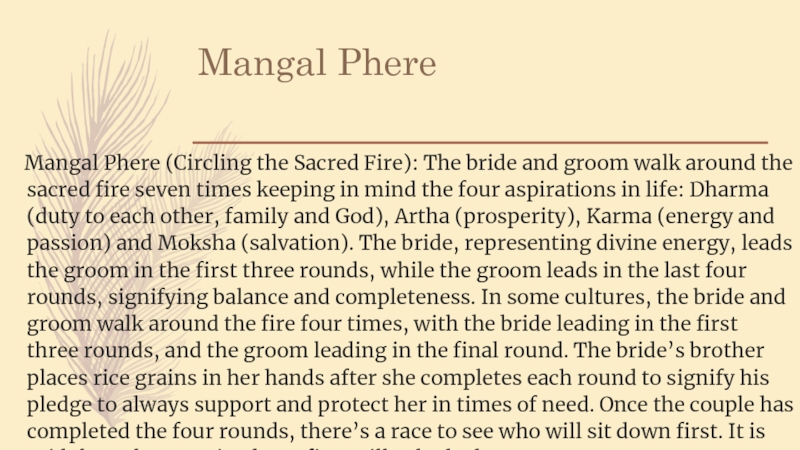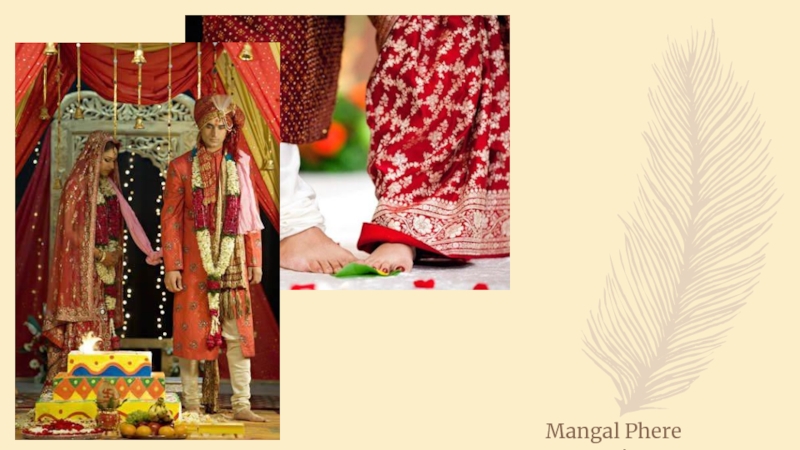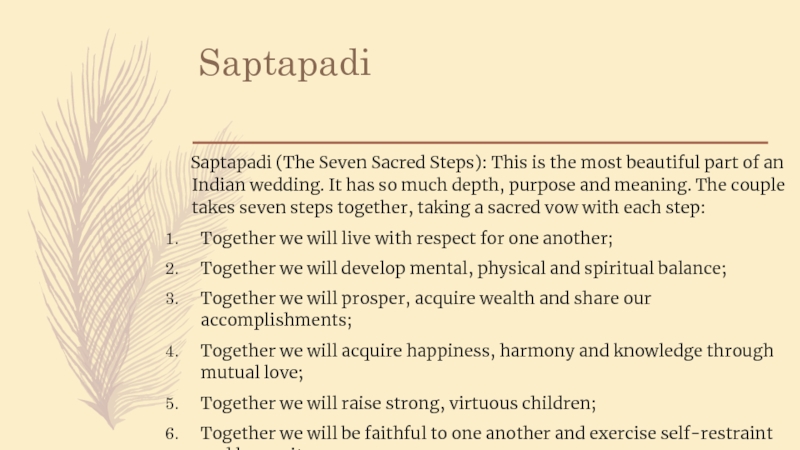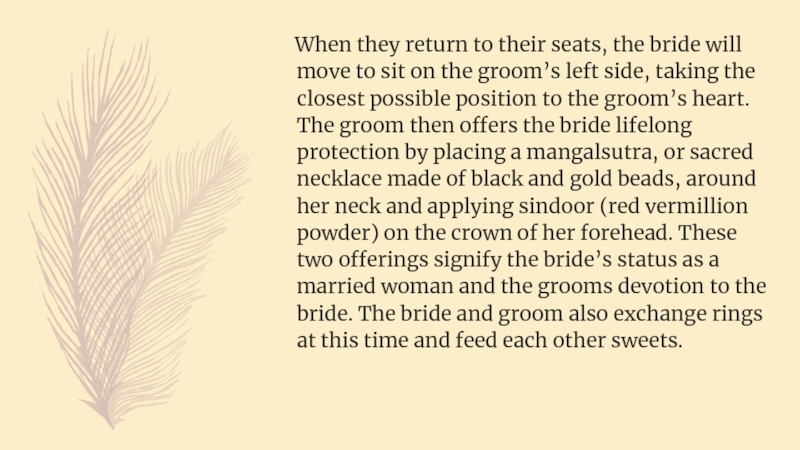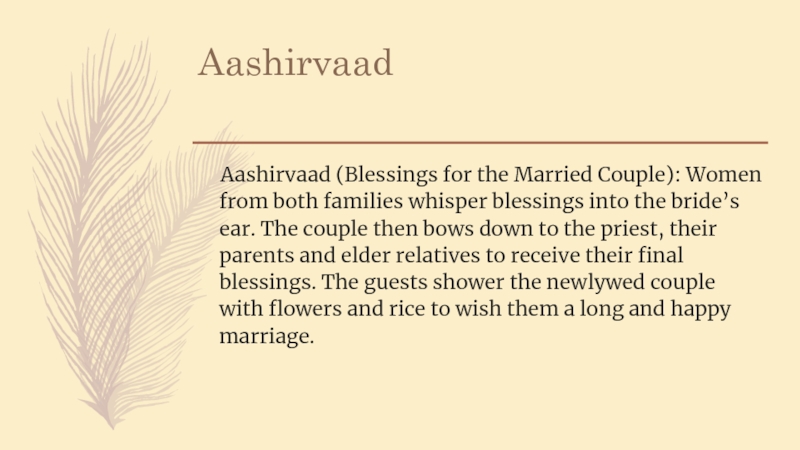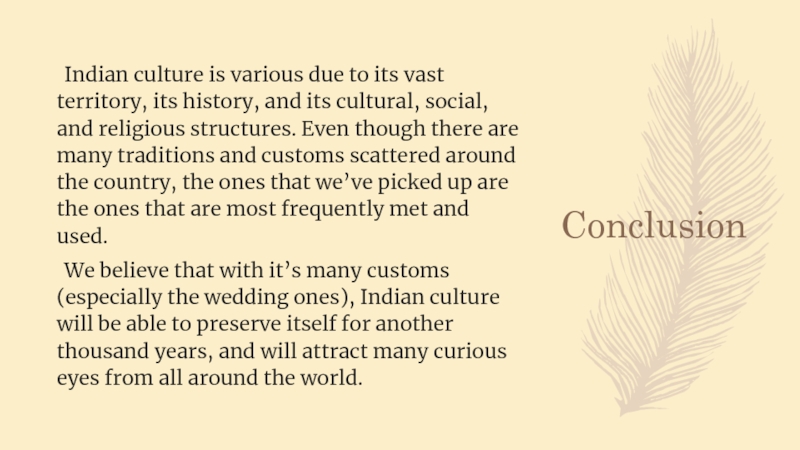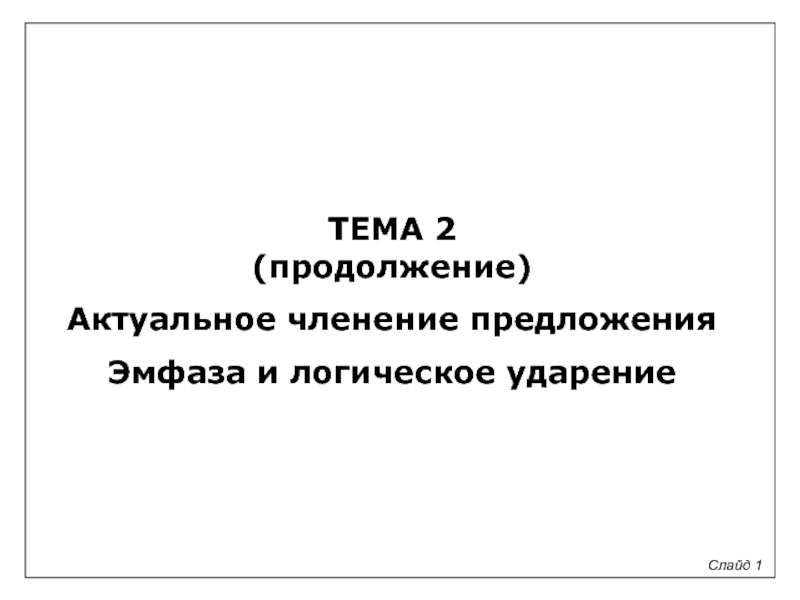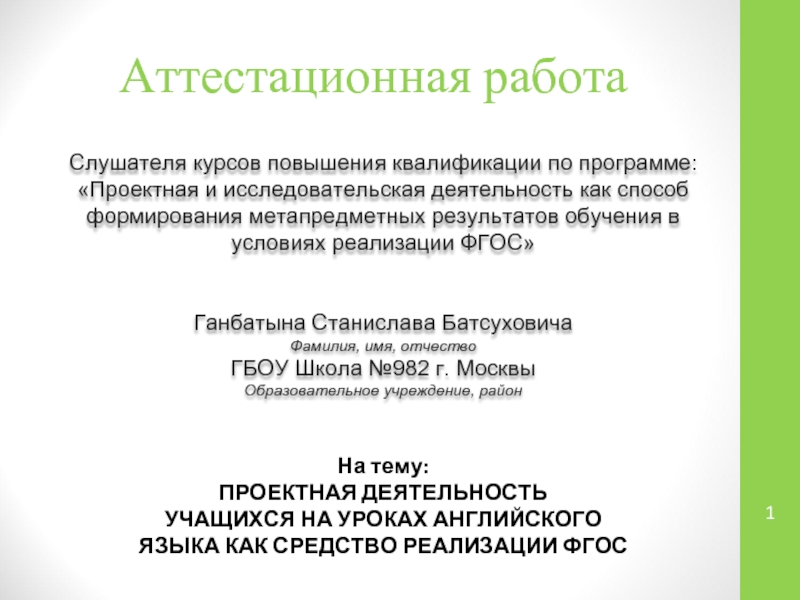- Главная
- Разное
- Дизайн
- Бизнес и предпринимательство
- Аналитика
- Образование
- Развлечения
- Красота и здоровье
- Финансы
- Государство
- Путешествия
- Спорт
- Недвижимость
- Армия
- Графика
- Культурология
- Еда и кулинария
- Лингвистика
- Английский язык
- Астрономия
- Алгебра
- Биология
- География
- Детские презентации
- Информатика
- История
- Литература
- Маркетинг
- Математика
- Медицина
- Менеджмент
- Музыка
- МХК
- Немецкий язык
- ОБЖ
- Обществознание
- Окружающий мир
- Педагогика
- Русский язык
- Технология
- Физика
- Философия
- Химия
- Шаблоны, картинки для презентаций
- Экология
- Экономика
- Юриспруденция
Indian wedding traditions презентация
Содержание
- 1. Indian wedding traditions
- 2. Contents Wedding Clothes; Pre-wedding rituals; The wedding ceremony; Conclusion.
- 3. Indian culture is very versatile, as it
- 4. Wedding clothes Sari and Dhoti
- 5. Sari and Dhoti In
- 6. Sari and Dhoti
- 7. Pre-wedding rituals Pitthi and Mehendi
- 8. Pitthi Pitthi is an
- 9. The Pitthi ritual
- 10. Mehendi The Mehndi event
- 11. The Mehendi ritual
- 12. The wedding ceremony
- 13. Baraat Baraat (The groom’s
- 14. The Baraat procession
- 15. Milni Milni (Meeting of
- 16. The Milni procession
- 17. Ganesh Puja Ganesh Puja
- 18. Kanya Aagman Kanya Aagaman
- 19. Jai Mala Jai Mala
- 20. Kanyadaan Hasta Melap Kanyadaan
- 21. Kanyadaan and Hasta Melap rituals
- 22. Vivah Havan Vivah Havan
- 23. Mangal Phere Mangal Phere
- 24. Mangal Phere procession
- 25. Saptapadi Saptapadi (The Seven
- 26. The Saptapadi ritual
- 27. When they return to their
- 28. Aashirvaad Aashirvaad (Blessings for
- 29. Bidaai Bidaai (Going away
- 30. Conclusion
- 31. Conclusion Indian culture is
Слайд 3Indian culture is very versatile, as it covers a vast territory
and has a long and colourful past. Hindu weddings, also called ‘Vivaah’, are best known for the grandeur, traditions, grace, colors and almost carnival-type celebration associated with this sacred event. It is worth mentioning that even though there are lots of different traditions from city to region, here are the most common of them. There has been so much already said about the rituals, layout and dynamic parts of the wedding, so we’d like to address the meaning and essence behind these fascinating rituals and the cultural significance of centuries-old traditions practiced during a Vivaah.
Слайд 5Sari and Dhoti
In India, the wedding rituals and
clothes make the wedding as much as that of the bride and her groom. Both look their splendid best in gorgeous clothes. Not just the couple, but the guests attending the family and the relatives are often seen dressed up to the teeth. The bride is dressed up in auspicious colors, whereas the bridegroom is dressed to exude a regal aura. The bridesmaids and best men are often dressed on a par with the bride and the groom. But they are toned down a bit because the day belongs to the couple. All the folks attending the marriage are decked out with gold jewelry including the bride and sometimes the groom. The ladies are additionally adorned with henna patterns all over their palms, hands, forearms, legs and feet. Sometimes henna patterns are replaced with alta designs which are short lived and easily removable.
Indian weddings generally tend to continue for several days and new attire is worn each day. All these dresses and the color symbolize the meaning of marriage and the period that follows it. Indian wedding is one that gives more importance to details like different rituals and the various attires one wears to attend them.
Indian weddings generally tend to continue for several days and new attire is worn each day. All these dresses and the color symbolize the meaning of marriage and the period that follows it. Indian wedding is one that gives more importance to details like different rituals and the various attires one wears to attend them.
Слайд 8Pitthi
Pitthi is an auspicious ritual performed for good
luck. Pitthi is a paste made mainly of turmeric, chickpea flour and rose water. Family members and well-wishers of the bride and groom apply the paste on the bride/groom’s skin. This yellow paste is thought to brighten and even the skin tone and is applied one of the days prior to the wedding ceremony.
Слайд 10Mehendi
The Mehndi event is a colorful and fun
celebration held the night before the wedding, which is traditionally celebrated by the women on the bride’s side of the family. Generally, a professional mehndi artist or relative will apply henna in intricate designs to the hands and feet of the bride and other women in the family. These intricate designs symbolize joy, beauty, spiritual awakening and offering. The bride’s mehendi sometimes goes half way to her knees. There is music, dance and full “Bollywood tamasha!”
Слайд 13Baraat
Baraat (The groom’s procession): Accompanied by his family
and friends in a festive procession known as the baraat, the groom arrives at the entrance of the wedding venue on a horse. The procession consists of his family and friends singing and dancing around him to music generally played by a professional dhol (large bass drum) player. The baraat is met by the bride’s family at the entrance to the wedding venue. It symbolizes the pleasure and happiness of the Groom’s family in accepting the bride as a part of their family; as their very own.
Слайд 15Milni
Milni (Meeting of the two families): The bride’s
mother greets the groom with a welcoming ritual. Relatives of the bride and groom embrace and greet each other with garlands. The bride’s family then escorts the groom to the mandap, a canopied altar where the ceremony is performed. The mandap represents the home that the bride and groom will make together.
Слайд 17Ganesh Puja
Ganesh Puja (Prayer to Lord Ganesh): The
ceremony begins with a worship of Lord Ganesh, the destroyer of all obstacles. The priest guides the groom and bride’s parents in offering flowers, sweets and prayer to Lord Ganesh.
Слайд 18Kanya Aagman
Kanya Aagaman (Arrival of the Bride): The
bride enters the hall and is escorted to the mandap by her maternal uncle and aunt, signifying that the bride’s maternal side approves of the union. In other parts of India, the bride is escorted by her sisters, cousins and close female friends.
Слайд 19Jai Mala
Jai Mala (Exchange of Garlands): Once the
bride approaches the mandap, the bride and groom exchange floral garlands, signifying their acceptance of one another.
Слайд 20Kanyadaan
Hasta Melap
Kanyadaan and Hasta Melap (Giving Away of
the Bride): At this point, the bride’s father pours sacred water in his daughter’s hand and places her hand in the groom’s hand, officially giving away his most precious gift to the groom. The groom’s sister or cousin then ties the end of the groom’s scarf to the bride’s sari with betelnuts, copper coins and rice, symbolizing unity, prosperity and happiness. The knot represents the eternal bond of marriage.
Слайд 22Vivah Havan
Vivah Havan (Lighting of the Sacred Fire):
The priest then lights the sacred fire or Agni. Agni symbolizes the divine presence as a witness of the ceremony. Commitments made in the presence of Agni are made in the presence of God.
Слайд 23Mangal Phere
Mangal Phere (Circling the Sacred Fire): The
bride and groom walk around the sacred fire seven times keeping in mind the four aspirations in life: Dharma (duty to each other, family and God), Artha (prosperity), Karma (energy and passion) and Moksha (salvation). The bride, representing divine energy, leads the groom in the first three rounds, while the groom leads in the last four rounds, signifying balance and completeness. In some cultures, the bride and groom walk around the fire four times, with the bride leading in the first three rounds, and the groom leading in the final round. The bride’s brother places rice grains in her hands after she completes each round to signify his pledge to always support and protect her in times of need. Once the couple has completed the four rounds, there’s a race to see who will sit down first. It is said that whoever sits down first will rule the house.
Слайд 25Saptapadi
Saptapadi (The Seven Sacred Steps): This is the
most beautiful part of an Indian wedding. It has so much depth, purpose and meaning. The couple takes seven steps together, taking a sacred vow with each step:
Together we will live with respect for one another;
Together we will develop mental, physical and spiritual balance;
Together we will prosper, acquire wealth and share our accomplishments;
Together we will acquire happiness, harmony and knowledge through mutual love;
Together we will raise strong, virtuous children;
Together we will be faithful to one another and exercise self-restraint and longevity;
Together we will remain lifelong partners and achieve salvation.
Together we will live with respect for one another;
Together we will develop mental, physical and spiritual balance;
Together we will prosper, acquire wealth and share our accomplishments;
Together we will acquire happiness, harmony and knowledge through mutual love;
Together we will raise strong, virtuous children;
Together we will be faithful to one another and exercise self-restraint and longevity;
Together we will remain lifelong partners and achieve salvation.
Слайд 27 When they return to their seats, the bride will
move to sit on the groom’s left side, taking the closest possible position to the groom’s heart. The groom then offers the bride lifelong protection by placing a mangalsutra, or sacred necklace made of black and gold beads, around her neck and applying sindoor (red vermillion powder) on the crown of her forehead. These two offerings signify the bride’s status as a married woman and the grooms devotion to the bride. The bride and groom also exchange rings at this time and feed each other sweets.
Слайд 28Aashirvaad
Aashirvaad (Blessings for the Married Couple): Women from
both families whisper blessings into the bride’s ear. The couple then bows down to the priest, their parents and elder relatives to receive their final blessings. The guests shower the newlywed couple with flowers and rice to wish them a long and happy marriage.
Слайд 29Bidaai
Bidaai (Going away of the Bride to the
Groom’s house) – The bride says her final goodbye to her family and the father gives his prized possession to the Groom’s father. The procession ends joyfully, yet is often bittersweet for those closest to the Bride and Groom.
Слайд 31Conclusion
Indian culture is various due to its vast
territory, its history, and its cultural, social, and religious structures. Even though there are many traditions and customs scattered around the country, the ones that we’ve picked up are the ones that are most frequently met and used.
We believe that with it’s many customs (especially the wedding ones), Indian culture will be able to preserve itself for another thousand years, and will attract many curious eyes from all around the world.
We believe that with it’s many customs (especially the wedding ones), Indian culture will be able to preserve itself for another thousand years, and will attract many curious eyes from all around the world.
